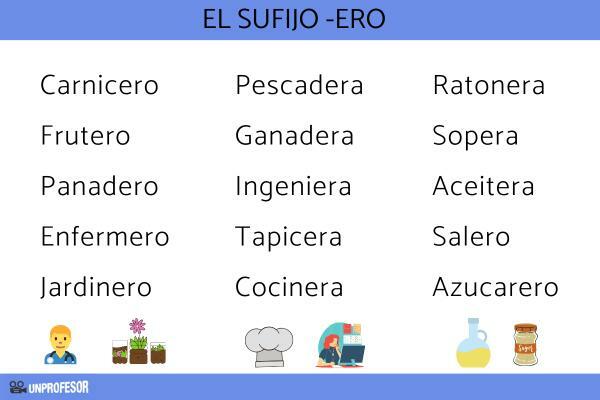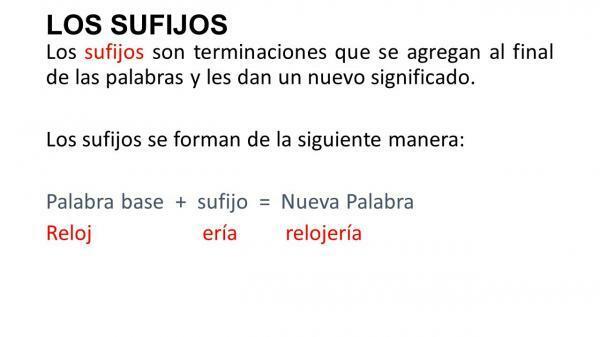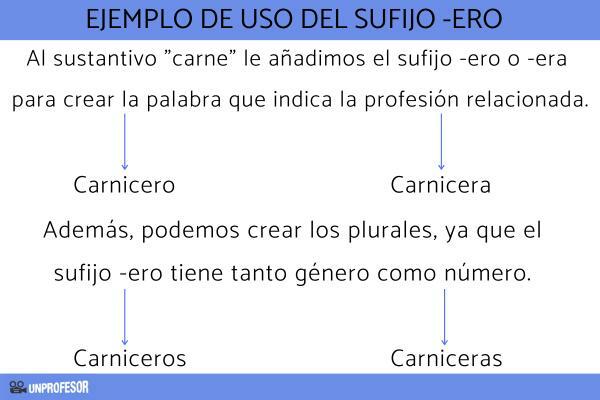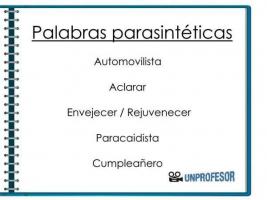SUFFIX –ERO: meaning and examples

Spanish is a very rich language that, thanks to the same root, manages to express different types of words and form a wide vocabulary. Thanks to the adhesion of different particles, we can transform a specific word by varying its initial meaning. Suffixes are one of the most commonly used particles to perform this operation.
In this lesson from a TEACHER we are going to focus on one of them, in this case we will talk about suffix -ero, its meaning and several examples so you know how to use it correctly.
Index
- What are suffixes
- Meaning of suffix -ero
- Can plurals be formed with the suffix -ero?
- Examples of the suffix -ero
What are suffixes.
Words in Spanish can have different elements that cause them to vary and acquire different meanings. The most common way to achieve this is to add prefixes and suffixes that are placed next to the root of the word and give it a new variety with a new meaning. These can even cause the word to change into another type. That is, from a verb we can obtain a noun, an adjective, etc.
Prefixes, as their name suggests are those who are placed in front of the root and that they are going to make it see its meaning modified. In the same way, suffixes are also particles used in Spanish but that are always placed at the end of the word, that is, behind the root.
Within the suffixes we can find Different types. These are characterized by their form and the function they fulfill with respect to the word, then, as We pointed out, these can make the classes of words transform and that these change from meaning.
To learn more about this topic, we recommend taking a look at a TEACHER's lesson on Prefixes and suffixes and more than 100 examples.

Image: Slideplayer
Meaning of the suffix -ero.
This time we want to talk about one of these suffixes, the suffix -ero. This particle is placed at the end of the root of a word to create a new one with a different meaning. Thanks to the suffixes such as –ero, in its male version and –era in its female version, we can create new nouns and adjectives through a verb or other types of words.
The suffix –ero / -era is one of the most used in Spanish because it is in charge of naming professions, occupations and utensils. That is, thanks to the fact that we add this suffix to the root of a word, we can make any of them go to name a profession or a utensil used to perform a certain action. To understand it better we are going to see a example explained.
- Let's start with the word meat, which is a feminine noun. If we want to point out the person who has his or her profession or occupation within the scope of this product and whose job it is to treat or sell it, we must add the corresponding prefix.
- In this case, if we want to indicate that the person who works with meat is a man, we will add the suffix –ero. In this way the word would be formed as follows: Butcher. In this case we see that the and of meat has become i. This is the result of an evolution of the word.
- In the event that the person who is dedicated to meat is female, we must adapt the suffix to match her gender. In this case, from the word meat, we would get the profession butcher. As in the previous case, the word has undergone a variation in the and, which has been replaced by the i.
Can plurals be formed with the suffix -ero?
Words with suffix -ero / -era can also form plurals, that is, they have gender and number. If we want to refer to several people with the same profession, we must always use the appropriate gender and number, so that they agree.
Considering the example above. The plural in this case, would be formed by adding as at the end of the suffix -ero / -era. In this way we would get the word butchers, in the case of male gender, and butchers, when it is female.

Examples of the suffix –ero.
As you can see, the use of the suffix -ero is quite common and easy to apply in words to form from them Professions. To understand it better we are going to see a series of -ero suffix examples:
- Baker
- Watchmaker
- Waiter
- Upholstery
- Nurse
- Cook
- Sewing box
- Engineer
- Postman
- Livestock
- Gardener
- Shoemaker
- Truck driver
- Fishwife
- Fruit platter
As you can see in these examples, some words can also have multiple meanings. As we indicated before in the definition of the suffix –ero. This can also designate Utensils that are used to work with certain elements. In the previous words we see a few examples: the word fruit bowl, for example, can refer to the profession, but also to the container that we use to leave the fruit. The same occurs with the words shoemaker, sewing, salt or sugar, which are also examples of this polysemy.
In addition, there are more words that are formed with this suffix and form the name of a utensil but that do not match with a profession such as, for example, salad bowl, oil can, tureen, vase, lemon tree, mousetrap, file, chest of drawers, etc.
If you want to read more articles similar to Suffix –ero: meaning and examples, we recommend that you enter our category of Grammar and Linguistics.

